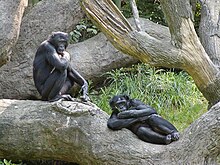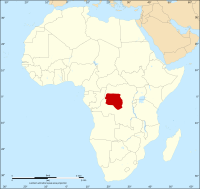The bonobo (Pan paniscus) is a great ape and the smaller of the two species making up the genus Pan (the other is Pan troglodytes, the common chimpanzee). The bonobo is sometimes called the dwarf or pygmy chimpanzee.[2] Although the name "chimpanzee" is sometimes used to refer to both species together, it is usually understood to mean the common chimpanzee, while Pan paniscus is usually referred to as the bonobo.
| Pan paniscus[1] | |
|---|---|

| |
| Bonobos at the Cincinnati Zoo | |
| Scientific classification | |
| Kingdom: | |
| Phylum: | |
| Class: | |
| Order: | |
| Family: | |
| Tribe: | |
| Genus: | |
| Species: | P. paniscus
|
| Binomial name | |
| Pan paniscus Schwarz, 1929
| |

| |
| Bonobo distribution | |
The bonobo lives in rain forest, in a 500,000 km2 (190,000 sq mi) area south of the Congo River. This is in the Democratic Republic of the Congo, Central Africa.
The bonobo has high levels of sexual behavior. Sex functions in conflict appeasement, affection, social status, excitement, and stress reduction. It occurs in virtually all partner combinations and in a variety of positions. This may explain the lower levels of aggression in the bonobo as compared to the common chimpanzee and other apes. Bonobos are matriarchal and a male's rank in the social hierarchy is often determined by his mother's rank.
The two chimpanzee species are separated by the huge Congo River. Its formation 1.5–2 million years ago may have led to the speciation of the bonobo. Their population is between 29,000 and 50,000 individuals. The species is listed as Endangered on the IUCN Red List. It is threatened by habitat destruction, human population growth and commercial poaching. The bonobo lives for about 40 years in captivity,[3] though its lifespan in the wild is unknown.
References
change- ↑ 1.0 1.1 Groves, Colin; Wilson D.E. and Reeder, D.M. (eds) 2005. Mammal species of the world. 3rd ed, Johns Hopkins University Press, 183.ISBN 0-801-88221-4
- ↑ de Waal, Frans; Lanting, Frans 1997 (1997). Bonobo: the forgotten ape. University of California Press. ISBN 0-520-20535-9.
{{cite book}}: CS1 maint: numeric names: authors list (link) - ↑ Rowe N. 1996. Pictural guide to the living primates. Pogonias Press, East Hampton.ISBN 0-9648825-1-5
